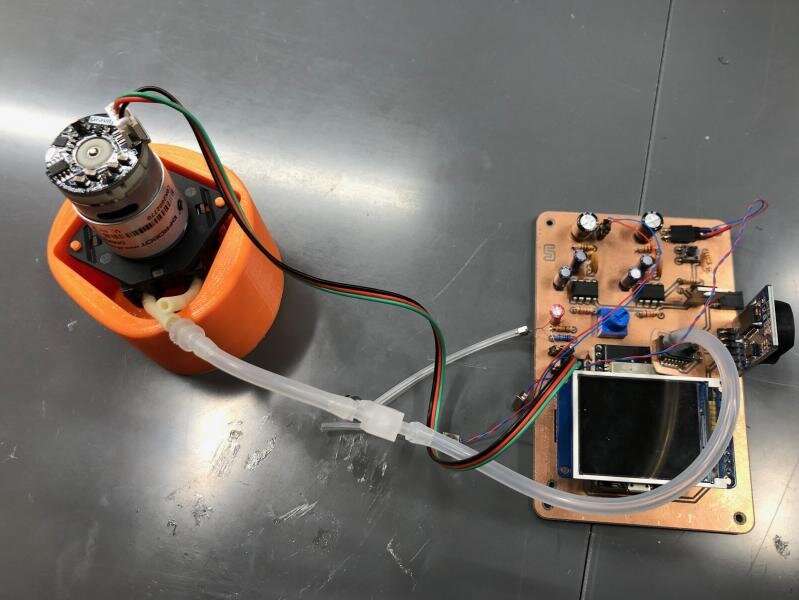A duke-developed tool addresses preventable hearing loss in children


The World Health Organization (WHO) estimates that around 60% of childhood hearing loss could be avoided through prevention measures. Preventable childhood hearing loss also disproportionately affects underserved populations and has lifelong consequences for language development, school achievement, and future employment opportunities.
Samantha Robler, AuD, Ph.D., from Norton Sound Health Corporation and Susan D. Emmett, MD, MPH, Associate Professor of Head and Neck Surgery and Audiology and Associate Professor of Global Health at Duke University, have been researching childhood hearing loss in remote and rural areas of Alaska. Their work identified a gap in the screening tools that can be used to identify children with hearing loss.
Current tympanometers, used for identifying middle ear disease, such as ear infections, are available but they are expensive and require trained audiologists, like Robler, to use and interpret the results. Including a tool that can identify middle ear disease is important for screening programs in underserved populations, where there is often a high prevalence of infection-related hearing loss. However, screening programs today don’t commonly include this tool due to cost and the need for an audiologist to conduct the test.
Robler and Emmett saw a need for an affordable and accessible tympanometer that could be used in schools and by community health workers and clinicians, particularly those in remote locales, to screen children for hearing loss. “Tympanometry is an essential tool for evaluating infection-related hearing loss, but a mobile and lay-friendly tympanometer to support mass screening programs just doesn’t exist,” said Robler.
Robler and Emmett approached Mark Palmeri, MD, Ph.D., a Professor of the Practice in the Department of Biomedical Engineering at Duke’s Pratt School of Engineering and Director of the BME Design Fellows program, about the potential for developing an innovative solution to make tympanometry accessible, affordable, and easy to use. A new collaboration was formed bringing together the clinicians, engineers, data scientists, and Alaska-based Norton Sound Health Corporation, to build a solution.
The team applied for funding from Duke MEDx (Medicine + Engineering) and received a grant in 2020 to jump start the project.
“MEDx has helped to find a home for this project through seed funding. The project truly has been a labor of love and through the support of MEDx, we were able to get this project off the ground,” said Palmeri.
Palmeri and his team, including Duke graduate students and undergraduate BME Design Fellows, have developed a novel mobile health (mHealth) tympanometer with a machine learning interface. The team believes that their mHealth tympanometer will have broad applicability and has the potential to improve diagnoses in community health settings, where access to a specialist can be limited. Teachers, school nurses, and frontline healthcare providers, could use the mHealth tympanometer for school- and community-based screening to identify children in need of ear and hearing care.
Machine learning is an integral part of this platform that allows a layperson to acquire the data and then have the device interpret the data to guide clinical decisions. Funding from the Duke Global Health Institute enabled development and evaluation of the utility of machine learning for automating a mHealth tympanometer. Felix Jin and Ouwen Huang, students in the Medical Scientist Training Program students who are pursuing Ph.D.s in Pratt, took on this part of the project with guidance from Palmeri and team.
Palmeri’s engineering team has developed a hardware prototype that can be used with a smartphone. Duke student engineering teams demonstrated “proof-of-concept” of the prototype, showing that it meets the requirements of low cost, ease of use, that it is comfortable when placed in a child’s ear—working quickly enough to be an effective screening tool.
“This project has given me and my peers an opportunity to use our individual skills and watch the project come together,” said Alexander Chen, Duke biomedical engineering undergraduate student. “I specifically found a passion for electronic computer-aided design after working with Dr. Palmeri and other students to find functional components in the project for testing and improving designs. The project is for a greater cause that gives us hands-on experience in supporting life changing innovation.”
Currently, the multidisciplinary team is working on the subsystems of the device to fine-tune specifications and find creative ways to drive down cost. By the end of 2022, the team expects to have the device ready to hand off for beta testing in volunteers. They aim to start incorporating the device in clinical trials in 2023.
“Right now, there isn’t a tool that is available and competitive in the market like the tympanometer we have developed,” said Palmeri. “COVID at-home testing has really accelerated the desire for these accessible and cost-effective tests. The long-term goal would be to implement this in our communities and clinically, and then be able to offer these screening tests as an option for parents and caregivers to purchase and use at home.”
The team believes that the mHealth tympanometer could benefit children across the world and ensure they are equally able to reach their full potential.
Source: Read Full Article